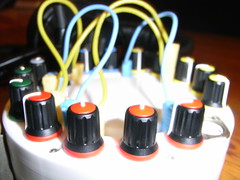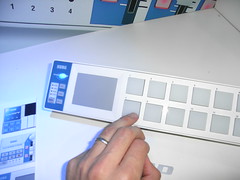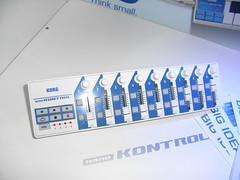
After a week with the
Chimera BC16, here's what I'm thinking...
The good bits:1. Looks great, and feels fantastically well made.
2. Intuitive, fun, educational interface. You'll learn more about how synths work in a few hours with this than with years of VST plugins. My
5 yr-old son immeditately fell in love with it, making helicopters and sirens and turning the sound down, randomly turning knobs, then turning it up to see what came out. Nothing is labelled, so you have to listen.
3. It makes a huge range of noises. The digital multi-waveform oscillator will annoy purists, but it's versatile. A reasonably effective two-oscs-in-one system can sound pretty fat.
4. It's a quirky, unique synth, hand made in Britain and absolutely in the lineage of
EMS,
EDP,
OSCar.
5. The sound is immediate, ballsy and gritty. Huge bass, huge brightness.
6. It's absolutely a real synth, not a toy. Compared with the
Tenori On, this is a real (if simple) instrument. It makes any sound you can patch, not a bunch of presets.
6. It has no blue LEDs, but several red and green ones.
7. It's totally self contained - 6xAAA batteries last a few evenings. There is a power supply on the way (soon).
8. In theory, they can make these in
any colour, including clear. That will be hot.
9. It's £136 shipped - the price of a Squier strat or an effects pedal, cheaper than many soft synths. The price is crucial, because it makes most of the other issues irrelevant.
The bad bits:1. It's really hardware in Beta (track the
updates on their blog). If you can wait a year, I think Chimera will either be out of business (and BC16s worth a
fortune on eBay), or shipping a more refined version.
2. The output from the 1/8th inch headphone output is super hot, and fairly noisy. To get the best sound for recording, you need to
make a mini banana plug -> 1/4 inch cable and take the sound direct. (They gave me one for this review and will be selling them soon)
3. The MIDI is being debugged as I write - barely works on mine, but should be much improved on the models being shipped now. If you can't imagine using it without midi, it's possibly not for you (yet).
4. There are a tonne of digital artefacts from the oscillators. I think it's cool, but if you're looking for silky analogue tone, buy a Moog Voyager at 14 times the price. Similarly, you're unlikely to write a love sonnet about the filter.
5. Delivery is flaky at the moment.
6. It's a perfect portable synth, but if you pull one out on a bus (let alone a 'plane), someone
will call the bomb squad.
My recent
computer woes mean I can't post any new sound samples, but the tried and tested 'loop random squiggles and add breakbeats' method was fun while it lasted.













